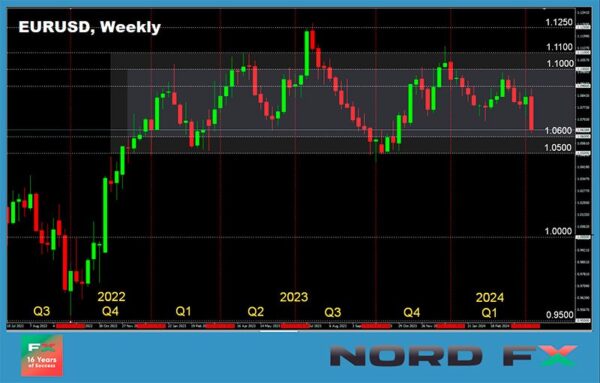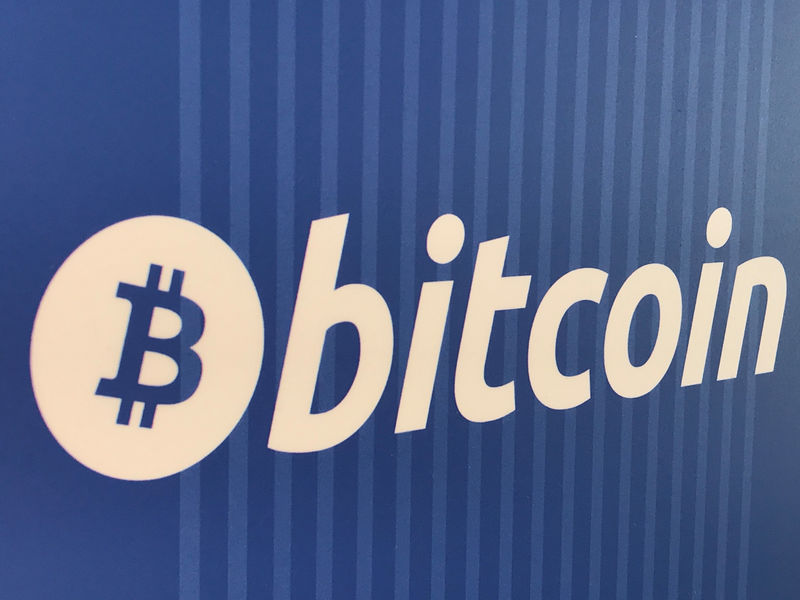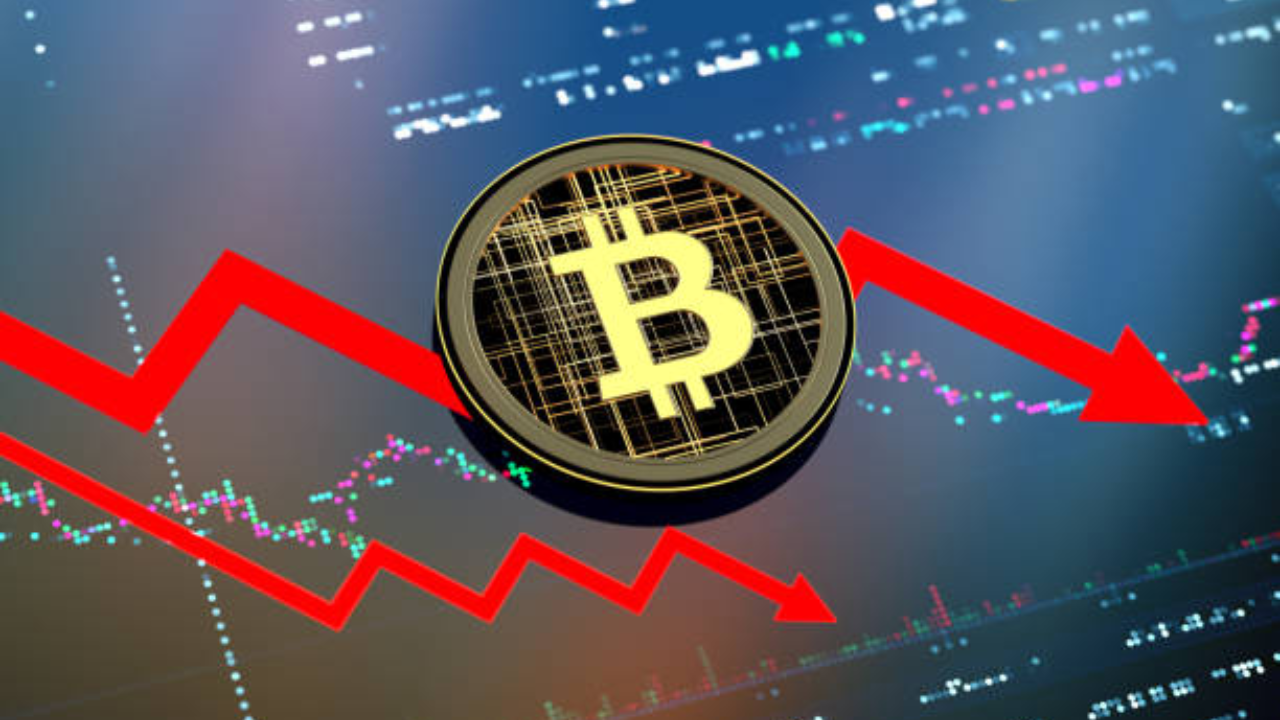Crypto
Forex and Cryptocurrency Forecast – Action Forex

EUR/USD: The Dollar Soars
Last week saw two significant events: the first shocked market participants, while the second passed without surprises. Let’s examine the details in order.
Since mid-2022, consumer prices in the US have been declining. In July 2022, the Consumer Price Index (CPI) was at 9.1%, but by July 2023, it had fallen to 3.0%. However, in October, the CPI rose to 3.7%, then decreased again, and by February 2024, it had dropped to 3.2%. As a result, there was a general perception that inflation had finally been brought under control. The market consensus was that the Federal Reserve would soon begin to ease its monetary policy and start reducing interest rates in June. Two weeks ago, the likelihood of this move was estimated at 70%. The DXY index began to fall, reaching a local low of 103.94 on 9 April. However, the dollar bears’ joy was short-lived, as fresh US inflation data released on Wednesday, 10 April, quickly changed the sentiment.
In annual terms, the Consumer Price Index (CPI) rose to 3.5%, marking the highest level in six months. The main drivers of this inflation increase were the rises in rental costs (5.7%) and transportation expenses (10.7%), which clearly caught the markets by surprise. The chances of a rate cut in June plummeted to zero, and the DXY dollar index soared, reaching a peak of 105.23 on the evening of 10 April. Alongside this, the yield on 10-year US Treasury bonds grew to 4.5%. As is typical in such scenarios, stock indices such as the S&P 500, Dow Jones, and Nasdaq declined, and the EUR/USD pair, after dropping over 150 points, fell to 1.0728.
Austan Goolsbee, President of the Chicago Federal Reserve Bank, stated that although the regulator is confidently moving towards its 2.0% inflation target, the Federal Reserve leadership still has much work to do to reduce inflation. His colleague, John Williams, President of the New York Fed, noted that the latest inflation data were disappointing and added that economic prospects remain uncertain.
As a result of these and other statements, it is now forecasted that the Fed will begin cutting interest rates only in September. Moreover, investors expect there will be only two rate cuts this year, not three. Some believe that there may not be any rate cuts at all in 2024. However, according to US President Joe Biden, the Fed should still lower the rate in the second half of this year. His insistent request is quite understandable on the eve of the presidential elections. Firstly, it would reduce the cost of servicing the country’s enormous national debt, and secondly, it would symbolize a victory over inflation, giving Biden several additional points in the battle for the White House.
After the American inflation reaction, markets took a brief pause, awaiting the European Central Bank (ECB) governing council meeting on 11 April. The ECB has held rates steady at 4.50% since September 2023, which was in line with market expectations as forecasted by all 77 economists surveyed by Reuters. Thus, after some fluctuation, EUR/USD returned to its pre-ECB meeting level.
The ECB press release affirmed the council’s firm intention to return inflation to a medium-term target of 2.0% and believed that the key rates contribute significantly to the ongoing disinflation process. Future decisions will ensure that the key rates remain at sufficiently restrictive levels as long as necessary.
It’s worth noting that inflation in the 20 Eurozone countries was at 2.4% in March, slightly above the target of 2.0%. In February, the rate was 2.6%, and in January it was 2.8%. Economists surveyed by Reuters believe that inflation will continue to decrease in the coming quarters, but it will not reach 2.0% before the second quarter of 2025.
Christine Lagarde, the head of the European Central Bank (ECB), expressed a similar view during a press conference. However, she mentioned that since the Eurozone economy remains weak, to support it, the ECB will not wait for inflation to return to the 2.0% level at every point. Thus, Ms. Lagarde did not rule out that the regulator might start easing its monetary policy significantly before 2025. Strategists from the Italian bank UniCredit forecast that the ECB will cut rates three times this year, by 25 basis points each quarter. The pace of reduction could remain the same next year. Economists from Deutsche Bank also expect that the pan-European regulator will start cutting rates before the Federal Reserve and will do so at a faster pace. Consequently, the widening interest rate differential between the US and the Eurozone will contribute to the weakening of the euro.
This medium-term forecast was confirmed last Friday: EUR/USD continued its decline, reaching a local minimum of 1.0622 and closing the five-day period at 1.0640. The DXY index peaked at 106.04. As for the near-term outlook, as of the evening of 12 April, 40% of experts anticipate an upward correction of the pair, while the majority (60%) hold a neutral position. Among the oscillators on D1, only 15% are coloured green, and 85% are red, although a quarter of them are in the oversold zone. Trend indicators are 100% bearish. The nearest support levels for the pair are located in the zones 1.0600-1.0620, followed by 1.0495-1.0515, 1.0450, 1.0375, 1.0255, 1.0130, and 1.0000. Resistance zones are situated at levels 1.0680-1.0695, 1.0725, 1.0795-1.0800, 1.0865, 1.0895-1.0925, 1.0965-1.0980, 1.1015, 1.1050, 1.1100-1.1140.
Next week, on Monday, 15 April, US retail sales data will be released. On Wednesday, it will become clear what is happening with consumer inflation in the Eurozone. It is likely that the refined data will confirm the preliminary results, and the Consumer Price Index (CPI) for March will be reported at 2.4% year-on-year. On Thursday, we traditionally expect data on the number of initial jobless claims from US residents and the Philadelphia Fed Manufacturing Index.

GBP/USD: The Pound Plummets
On Friday, 12 February, the UK’s GDP data indicated that the economy is on the path to recovery. Although production has declined compared to last year, the latest data suggests that exiting the shallow recession is quite likely. GDP has grown for the second consecutive month, with the Office for National Statistics (ONS) reporting a 0.1% increase in February on a monthly basis, with January’s figures revised upwards to show a 0.3% growth from an earlier 0.2%.
Despite these figures, GBP/USD fell below the key 1.2500 mark due to crumbling hopes for an imminent Fed rate cut. Not even a statement from Bank of England (BoE) Monetary Policy Committee member Megan Greene, which highlighted that inflation risks in the UK remain significantly higher than in the US and that markets are mistaken in their rate cut forecasts, could change the situation. “Markets have leaned towards the Fed not cutting rates so soon. In my view, the UK will also not see rate cuts anytime soon,” she wrote in her Financial Times column.
Following Greene’s remarks, traders now expect no more than two rate cuts from the Bank of England this year, each by 25 basis points. However, this revised forecast did little to support the pound against the dollar, with GBP/USD ending the week at 1.2448.
Analysts are split on the short-term behaviour of GBP/USD: 50% voted for a rebound to the north, and 50% abstained from forecasting. Indicator readings on D1 suggest the following: among oscillators, 10% recommend buying, another 10% are neutral, and 80% indicate selling, with 20% of these signalling oversold conditions. All trend indicators are pointing downwards. If the pair continues south, it will encounter support levels at 1.2425, 1.2375-1.2390, 1.2185-1.2210, 1.2110, and 1.2035-1.2070. In the event of an increase, resistance will be found at levels 1.2515, 1.2575-1.2610, 1.2695-1.2710, 1.2755-1.2775, 1.2800-1.2820, 1.2880-1.2900, 1.2940, 1.3000, and 1.3140.
The most significant days for the British currency next week will be Tuesday and Wednesday. Extensive labor market data from the United Kingdom will be released on Tuesday, 16 April, along with a speech from the Governor of the Bank of England, Andrew Bailey. Wednesday, 17 April, could be even more turbulent and volatile as consumer inflation (CPI) data for the country will be published.
USD/JPY: Is 300.00 Just a Matter of Time?
Bears on USD/JPY continue to hope for its reversal southwards, yet the pair does not stop climbing. Our previous review titled “A Break Above 152.00 – A Matter of Time?” proved true within a very short period. Last week, the pair reached a 34-year high of 153.37, propelled by US inflation reports and increases in the DXY index and yields on 10-year US treasuries. (Considering that it traded above 300.00 in 1974, this is still not the limit).
This surge occurred despite another round of verbal interventions from high-ranking Japanese officials. Finance Minister Suzuki Shunichi reiterated his concern over excessive currency movements and did not rule out any options to combat them. Cabinet Secretary Yoshimasa Hayashi echoed these sentiments almost verbatim. However, the national currency no longer pays any attention to such statements. Only real currency interventions and significant steps towards tightening monetary policy by the Bank of Japan (BoJ) could help, but these have yet to occur.
Analysts at Dutch Rabobank believe the Japanese Ministry of Finance will eventually be forced to act to prevent the price from reaching 155.00. “While a breakthrough of the 152.00 level by USD/JPY might not immediately trigger currency interventions, we see a significant likelihood of such a step,” they write. “Assuming that the Bank of Japan may announce a second rate hike later this year and considering expectations that the Fed will indeed cut rates in 2024, Rabobank expects USD/JPY to trade around 150.00 on a monthly horizon and 148.00 on a 3-month horizon.”.
Last week, the pair closed at 152.26. Regarding its near future, 25% of experts sided with the bears, another 25% remained neutral, and the remaining 50% voted for further strengthening of the US currency and a rise in the pair. Technical analysis tools are apparently unaware of the fears regarding possible currency interventions, so all 100% of trend indicators and oscillators on D1 are pointing north, with a quarter of them now in the overbought zone. The nearest support level is around 152.75, followed by 151.55-151.75, 150.80-151.15, 149.70-150.00, 148.40, 147.30-147.60, and 146.50. Defining resistance levels after the pair updated 34-year highs is challenging. The nearest resistance lies in the zone 153.40-153.50, followed by levels 154.40 and 156.25. According to some analysts, the monthly high of June 1990 at around 155.80 and then the reversal high of April 1990 at 160.30 can also serve as references.
No significant events or publications regarding the state of the Japanese economy are planned for the upcoming week.
CRYPTOCURRENCIES: On the Eve of Hour X
The next halving, when the reward for mining a BTC block will again be halved, is scheduled for Saturday, 20 April. Although this date is approximate and may shift a day or two either way, the closer the Hour X, the hotter the discussions about how the price of the main cryptocurrency will behave before and after this event.
Historically, the value of bitcoin has risen after halvings: it surged by nearly 9000% to $1162 in 2012, by about 4200% to $19800 in 2016, and by 683% to $69000 following the previous halving in May 2020. However, it then crashed to nearly $16,000.
Lucas Kiely, CIO of the financial platform Yield App, believes that we should not expect a seven-fold increase in the price of bitcoin after the upcoming halving. According to Kiely, during the three previous cycles, the halving of miners’ rewards heralded a massive increase in volatility levels. After the halving, BTC fell by 30-40% but then soared to unprecedented heights within 480 days. However, this year, he suspects, the cryptocurrency’s flight to the Moon will not occur.
Kiely predicts that bitcoin will update its historical maximum reached this March at $73,743. However, the new peak will not exceed the previous one by as much as before, due to the low level of volatility. The specialist attributes the drop in volatility to two factors: 1. an increase in the number of bitcoins in the wallets of hodlers, who own more than 70% of the issued coins, and 2. the creation of spot Bitcoin ETFs, which remove a huge amount of coins from circulation. (In the three months since their inception, the capitalization of 10 such ETFs (excluding the Grayscale fund) has exceeded $12 billion). As a result, bitcoin is becoming a more traditional asset that is less risky but also less likely to yield massive profits. Kiely believes that this factor makes the coin more attractive to institutional investors and older people who prefer to invest in reliable assets and are not interested in gambling.
Ex-CEO of the BitMEX exchange, Arthur Hayes, expects a price drop. In his view, the halving is certainly a bullish catalyst for the crypto market in the medium term. However, prices might fall immediately before and after the event. “The narrative that the halving of block rewards will positively affect cryptocurrency prices has firmly taken root,” says the expert. “However, when most market participants agree on a certain outcome, the opposite usually happens.”
Hayes noted that the market would face a reduction in US dollar liquidity in the second half of April, driven by tax season, Fed policies, and the strengthening of the US Treasury’s balance sheet. This reduction in liquidity will provide additional stimulus for a “furious sell-off of cryptocurrencies,” he believes. “Can the market defy my bearish forecasts and continue to grow? I hope so. I have been involved with cryptocurrency for a long time, so I welcome being proven wrong.”
The situation before this halving is indeed very different from before. This change is linked to the large influx of institutional investors through the newly launched Bitcoin ETFs in early January. The influence of ETFs on spot trading is clearly reflected in the reduced market activity on weekends and US public holidays when the exchange funds do not operate. The tax season has also significantly impacted the market for risky assets. Over the last two weeks, inflows into these funds have been significantly below the average mark of $203 million, with recent days seeing an outflow of funds from Grayscale and Ark Invest. Other ETFs are also reporting reduced inflows. All this suggests that Arthur Hayes’ concerns are well-founded, and a 30% drop from the current price could send bitcoin down to around $50,000.
Miners, who will lose half their income after the halving, while the costs of obtaining the same amount of coins will increase, could also contribute to a market crash. After the halving in May 2020, the costs of mining rose to $30,000. Currently, the average cost of mining one BTC is $49,900, but after 20 April, according to Ki Young Ju, CEO of the analytical platform CryptoQuant, it will exceed $80,000. Therefore, the asset must trade above this level for miners to continue making any profit. However, as previously mentioned, a rapid price surge may not occur. This means that small mining companies and individual miners are facing a wave of bankruptcies and acquisitions.
According to Arthur Hayes, the situation might improve in May-June: the US Treasury will “most likely release an additional $1 trillion of liquidity into the system, which will pump the markets,” he says. Anthony Scaramucci, CEO of Skybridge, also holds that spot Bitcoin ETFs, acting as “selling machines,” will continue to stimulate demand for the first cryptocurrency from both retail customers and institutional investors. Scaramucci believes that in this cycle, bitcoin’s value could increase by 2.5 times, and then continue to rise. “I’m just saying that the capitalization of bitcoin could reach half that of gold, i.e., increase six or even eight times from its current levels,” the businessman declared. It’s noteworthy that the current capitalization of bitcoin stands at $1.35 trillion, while gold’s is at $15.8 trillion. Thus, if BTC reaches half the capitalization of the precious metal, its price would be around $400,000 per coin.
Brad Garlinghouse, CEO of Ripple, also places his hopes on spot Bitcoin ETFs. According to him, BTC-ETFs have attracted real institutional investments into the industry for the first time, so he is “very optimistic” about the macroeconomic trends in the crypto industry. In this context, Garlinghouse allowed that the market capitalization of digital assets could double by the end of the year, exceeding $5.0 trillion.
As of the evening of Friday, 12 April, BTC/USD is trading at around $66,900. The total capitalization of the crypto market is $2.44 trillion ($2.53 trillion a week ago). The Crypto Fear and Greed Index remains in the Extreme Greed zone at 79 points.
In conclusion, a bit of curious statistics: In anticipation of the halving, Deutsche Bank conducted a survey regarding the future price of bitcoin. 15% of respondents stated that within this year, BTC would trade in the range above $40,000 but below $75,000. A third of respondents were confident that the value of the main cryptocurrency would fall below $20,000 early in the next year. Meanwhile, 38% of those surveyed believed that BTC would cease to exist in the market altogether. And finally, about 1% of respondents called bitcoin a complete misunderstanding and speculation.

Crypto
Polygon (MATIC) vs. Solana (SOL) vs. Retik Finance (RETIK): Which Cryptocurrency Will Skyrocket Your Holdings 20X by 2025? | Bitcoinist.com

A select few projects have emerged as potential game-changers, promising unprecedented growth and unparalleled opportunities. Among these, Polygon (MATIC), Solana (SOL), and the newcomer Retik Finance (RETIK) stand out, capturing the attention of investors worldwide. With a remarkable $32.05 million raised during its recently concluded presale, Retik Finance has already established itself as a key player in the upcoming bull market. But the question remains: Which of these digital assets will catapult your holdings to a remarkable 20x surge by 2025?
Polygon (MATIC): Scaling Ethereum’s Horizons
Polygon (MATIC), a Layer 2 scaling solution for Ethereum, has been making waves in the cryptocurrency space. By addressing Ethereum’s scalability challenges, Polygon has positioned itself as a viable option for decentralized applications (dApps) seeking faster and cheaper transactions. Despite its recent price dip, Polygon’s impressive partnerships and growing ecosystem suggest a promising future. However, with increasing competition and Ethereum’s ongoing developments, Polygon’s ability to sustain its momentum remains uncertain.
Solana (SOL): The High-Performance Blockchain
Solana (SOL) has garnered significant attention for its high-performance blockchain, boasting lightning-fast transaction speeds and low fees. This innovative project has attracted diverse decentralized applications, from decentralized finance (DeFi) protocols to non-fungible token (NFT) marketplaces. While Solana’s potential is undeniable, recent network outages and concerns over its centralization have raised eyebrows among skeptics. Additionally, the unstaking of 14 million SOL tokens by node validators, valued at $2.7 billion, could potentially slow Solana’s upward trajectory.
Retik Finance (RETIK): The Real-World DeFi Disruptor
Retik Finance (RETIK) has emerged as a trailblazer in the DeFi space, offering a suite of innovative financial solutions tailored for the real world. Focusing on bridging traditional finance and decentralized technologies, Retik Finance is introducing groundbreaking features that set it apart from its peers. At the forefront of Retik Finance’s offerings are its virtual DeFi debit cards, a game-changing solution that allows users to transact with cryptocurrencies seamlessly in the real world.
Retik Finance has already launched the beta version of these debit cards long ahead of schedule, demonstrating its commitment to delivering cutting-edge solutions. Complementing the DeFi debit cards is Retik Pay, a smart crypto payment gateway that facilitates effortless transactions across various platforms. This feature aims to make cryptocurrency payments as convenient as traditional payment methods, fostering mass adoption and real-world utility. Retik Finance’s multi-chain, non-custodial wallet ensures the highest level of security for users’ digital assets. By prioritizing decentralization and user control, Retik Finance empowers individuals to manage their funds without relying on third-party intermediaries.
One of Retik Finance’s standout offerings is its AI-powered peer-to-peer (P2P) lending platform. Leveraging advanced algorithms and machine learning, this innovative feature streamlines the lending process, enabling efficient and accurate risk assessments. Retik Finance is poised to disrupt traditional lending models by democratizing access to credit and fostering financial inclusion.
The Road Ahead: Exponential Growth Potential
Retik Finance’s focus on real-world utility and innovative solutions positions it as a frontrunner for exponential growth as the cryptocurrency market continues to evolve. With its unique offerings, robust ecosystem, and committed community, Retik Finance has the potential to outpace its competitors and deliver unprecedented returns to early adopters.
Visit the links below for more information about Retik Finance (RETIK):
Website: https://retik.com
Whitepaper: https://retik.com/retik-whitepaper.pdf
Twitter: www.twitter.com/retikfinance
Telegram: www.t.me/retikfinance
Disclaimer: This is a paid release. The statements, views and opinions expressed in this column are solely those of the content provider and do not necessarily represent those of Bitcoinist. Bitcoinist does not guarantee the accuracy or timeliness of information available in such content. Do your research and invest at your own risk.
Crypto
Bitcoin price today: recovers to $59k but rate fears cloud outlook By Investing.com

Investing.com– Bitcoin price rose on Friday, taking some relief from a sharp drop in the dollar, although the outlook for the cryptocurrency remained bleak in the face of high for longer U.S. interest rates.
Traders also remained largely averse towards cryptocurrencies ahead of key nonfarm payrolls data on Friday, which is likely to factor into the outlook for interest rates.
rose 3.7% in the past 24 hours to $59,529.4 by 01:07 ET (05:07 GMT). The world’s largest cryptocurrency remained close to bear market territory after tumbling over 20% from a record high hit in March.
Dollar drop offers some relief to Bitcoin, but weekly losses on tap
A sharp overnight drop in the gave Bitcoin and other cryptocurrencies some breathing room, although they were still headed for losses this week.
Bitcoin was trading down 6.2% for this week, with traders remaining averse towards crypto in the face of high-for-longer U.S. interest rates.
This was also seen with Bitcoin investment products, specifically spot exchange-traded funds, clocking three straight weeks of declines. While approval of the ETFs had driven Bitcoin prices to record highs in March, enthusiasm over the approval now appeared to be running dry.
This also kept Bitcoin trading between $60,000 to $70,000 for over a month, although it broke below that trading range this week.
Crypto price today: Altcoins advance ahead of nonfarm payrolls
Most altcoins tracked gains in Bitcoin, recovering a measure of losses seen earlier this week.
But gains were limited by anticipation of key U.S. data, which is likely to factor into the outlook for interest rates.
remove ads
.
World no.2 token rose 2.6% to $2,999.45, while and added 8% and 1.7%, respectively.
All three altcoins were trading in a flat-to-low range for the week. The prospect of high U.S. interest rates bodes poorly for crypto markets, given that their speculative nature sees them thrive in a low-rate, high-liquidity environment.
data due later on Friday is expected to show persistent strength in the U.S. labor market- a scenario that gives the Fed more headroom to keep rates high for longer.
The central bank had warned earlier this week that it had no immediate plans to reduce rates, especially amid recent signs of sticky U.S. inflation.
Crypto
Cryptocurrency: Top 3 Layer 2 Coins By Development Activity To Buy Now

Cryptocurrency investors are increasingly focusing on projects with strong fundamentals and active development. Layer 2 solutions, which aim to improve the scalability and efficiency of blockchain networks, have garnered significant attention in recent months.
According to a recent tweet by Santiment, a leading cryptocurrency analytics platform, three Layer 2 coins stand out in terms of development activity: Optimism (OP), Starknet (STRK), and Arbitrum (ARB).
Also read: Shiba Inu: Machine Learning AI Predicts SHIB Price for May 5
Optimism (OP)

Optimism, a Layer 2 scaling solution for Ethereum, has claimed the top spot on Santiment’s list of Layer 2 cryptocurrencies by development activity. In addition, the project has made significant strides in improving the Ethereum network’s scalability and user experience, attracting both developers and users.
According to Santiment’s data, Optimism has an impressive 146% more daily development activity than the next closest project.
This high level of activity suggests that the Optimism team is actively working on improving the protocol and expanding its ecosystem. Currently trading at $2.74, OP has experienced an 8.13% increase in the past 24 hours.
Also read: Shiba Inu: Here’s How to Be a Millionaire When SHIB Hits $0.001
Starknet (STRK)


Starknet, a Layer 2 scaling solution that utilizes zero-knowledge proofs to enable fast and secure transactions, has secured the second spot on Santiment’s list.
Additionally, the project has been gaining traction among developers and investors for its innovative approach to scaling and its potential to unlock new use cases for blockchain technology. Currently trading at $1.28, STRK has experienced a 6.45% increase in the past 24 hours.
Also read: Cardano Transactions Exceeding $100k Explodes: Can ADA Hit $0.5 In May?
Arbitrum (ARB)

Arbitrum, another Layer 2 scaling solution for Ethereum that utilizes optimistic rollups, has claimed the third spot on Santiment’s list. The project has made significant progress in improving the Ethereum network’s scalability and user experience, attracting developers and users who want faster and cheaper transactions.
With a strong focus on development activity and a growing ecosystem, Arbitrum is well-positioned to continue its growth and adoption in the coming months. Currently trading at $1.02, ARB has experienced a 1.35% increase in the past 24 hours.
Layer 2 solutions like Optimism, Starknet, and Arbitrum are poised for significant growth and adoption. In addition, these projects, which have demonstrated high levels of development activity and strong fundamentals, present attractive investment opportunities for those looking to capitalize on the future of blockchain technology.
-

 News1 week ago
News1 week agoLarry Webb’s deathbed confession solves 2000 cold case murder of Susan and Natasha Carter, 10, whose remains were found hours after he died
-

 World1 week ago
World1 week agoHaiti Prime Minister Ariel Henry resigns, transitional council takes power
-

 News1 week ago
News1 week agoFirst cargo ship passes through new channel since Baltimore bridge collapse
-

 World1 week ago
World1 week agoUS secretly sent long-range ATACMS weapons to Ukraine
-

 World1 week ago
World1 week agoSpanish PM Pedro Sanchez suspends public duties to 'reflect'
-

 News1 week ago
News1 week agoAmerican Airlines passenger alleges discrimination over use of first-class restroom
-

 Movie Reviews1 week ago
Movie Reviews1 week agoHumane (2024) – Movie Review
-

 Education1 week ago
Education1 week agoVideo: Johnson Condemns Pro-Palestinian Protests at Columbia University


















